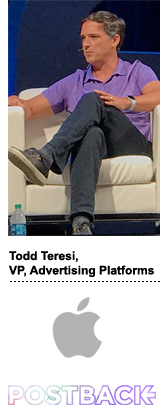
Apple sits on a trove of first-party customer data through its App Store, everything from credit card information to time-stamped app downloads tied to specific device IDs.
Yet there are inconsistencies between the install counts and engagement metrics developers see in Apple’s UI and what they’re told by their third-party measurement partners – and that’s “not acceptable,” said Todd Teresi, VP of advertising platforms, speaking at Tune’s Postback on Friday in Seattle.
“We can’t have an industry and a marketplace that doesn’t understand what’s going on,” said Teresi, who leads the teams focused on Apple News advertising and App Store search ads. Teresi previously spent four years as VP of Apple’s ill-fated mobile ad platform, iAd, the programmatic portion of which was shuttered in early 2016.
Apple is notoriously discreet and discerning about privacy, data collection and sharing user information.
But Teresi acknowledged that Apple can stick to its privacy guns while still giving developers better information to help them make smarter, more data-driven business decisions.
“We want to be transparent,” he said. “But we’re going to honor privacy requests.”
With transparency in mind, Teresi and his team decided to figure out why developers were seeing discrepancies in their install numbers, and found three culprits: Limit Ad Tracking (LAT), app open latency and re-downloaded apps.
Discrepancy Source No. 1: LAT
With iOS 10, which came out in September, Apple gave users the ability to opt out of ad tracking, which means that when a third-party ad partner pings Apple’s attribution API, Apple sends back a hashed identifier rather than a unique advertiser ID.
Although ad networks can’t target or track that person individually and measurement providers can’t connect specific downloads to specific people, Apple does report that information in aggregate form.
So far, roughly 15% to 25% of Apple users have enabled LAT, and Apple respects their desire for anonymity, Teresi said.
“They requested us not to [pass that information],” he said. “The industry is going to have to live with a 15% to 20% LAT rate.”

Discrepancy Source No. 2: Open Latency
Although Apple has observed that around 90% of apps are downloaded immediately after a user clicks on a search ad in the App Store, and another 8% download within three hours, a small contingent of people take longer to install and open an app.
The reasons for the lag time vary: a dropped cell connection, a forgotten password, a phone call, a notification or any number of other distractions that can delay a person from actually opening an app after downloading it.
And installs are only counted as such after a user opens an app for the first time.
But as Tune CEO Peter Hamilton pointed out, it can sometimes take up to two weeks or more for the initial open to happen.
Although Apple search ad conversions are attributed within a 30-day tap-through window, most measurement vendors in the industry abide by a seven-day window, which leaves room for latent app opens to fall through the cracks on the third-party partner side.
Discrepancy Source No. 3: Re-downloads And App Deletion
Apple doesn’t tell developers when users delete an app, Teresi said, so users aren’t deluged with “We miss you, come back” emails and other “noise.”
But if users later re-download the same app, the developer won’t know to count it as a new install. To the developer, a reinstall looks like the user is simply reopening an existing app.
Re-downloads account for around 15% of installs, but that number can shoot up as high as 60% for some apps. Consider dating applications, for example. Users often delete a dating app after they start seeing someone steadily, but if that relationship doesn’t work out, they’ll re-download the app and try for love again.
Developers need a way to understand the edge cases if they’re going to truly understand customer lifetime value.
Apple isn’t planning to give full access to its coffers of data, but the company is increasingly willing to work with third parties like Tune, Teresi said, to expose more reinstall-related information in its developer-facing App Store interface.
“In the short term, it might be as simple as exposing it in the US so there is the ability to do reconciliation,” he said. “In the longer term, we want the data to flow. We need to work through the details.”
This post was syndicated from Ad Exchanger.

More Stories
Marketing Morsels: Hidden Valley Ranch, La-Z-Boy, Topps & More
Flashback: Jane Pauley and Deborah Norville Revisit Today’s 1989 Succession Drama
Ally Financial Revives ‘Banksgiving’ With A TikTok Twist